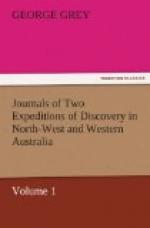REMARKABLE NEST.
I have already spoken in the 9th chapter of a very curious sort of nest which was frequently found by myself and other individuals of the party, not only along the seashore, but in some instances at a distance of six or seven miles from it. This nest, which is figured in Illustration 19, I once conceived must have belonged to the kangaroo rat I have above mentioned, until Mr. Gould, who has lately returned from Australia, informed me that it is the run or playing ground of the bird he has named Chalmydera nuchalis.
These nests were formed of dead grass, and parts of bushes, sunk a slight depth into two parallel furrows, in sandy soil, and then nicely arched above. But the most remarkable fact connected with them was that they were always full of broken shells, large heaps of which protruded from each extremity of the nest. These were invariably seashells. In one instance, in the nest most remote from the sea that we discovered, one of the men of the party found and brought to me the stone of some fruit which had evidently been rolled in the sea; these stones he found lying in a heap in the nest, and they are now in my possession.
EMUS.
I have seen no Emus in North-western Australia, but on two occasions their tracks were impressed in the mud on some plains lying on the banks of Glenelg River; and Mr. Dring, of H.M.S. Beagle, informed me that, whilst that vessel was employed in the survey of Fitzroy River, about seventy miles to the southward of the former, he not only several times saw traces of them but that, on one occasion when he was in the bush, two of them passed within a few yards of him. They may, I conceive, therefore be considered as inhabitants of this part of the continent.
ALLIGATORS.
No alligators were seen by the land party in any of the rivers of North-western Australia, but the crew of the schooner saw one in Hanover Bay. I can however safely assert from my own experience that they are by no means numerous upon this coast. At the islands of Timor and Roti however they abound.
TURTLES.
Turtles were abundant on the coast, and a freshwater tortoise was found inland.
PLANTS.
Amongst the vegetable kingdom I shall only observe generally that the Calamus, or rattan, which in King’s voyage* is considered to be peculiar to the primary granitic formation on the east coast, is abundant in the interior of the north-west between latitude 15 and 17 degrees south.
(Footnote. Appendix, volume 2.)
I found a dwarf cabbage-palm between 15 and 16 degrees south latitude, always in moist situations in the neighbourhood of streams, although not immediately on the banks.
Of the family of Urticeae many species of Ficus were observed.
The Banksia, common to Swan River, and bearing a yellow flower, is to be found in many of the valleys on the north-west coast; thus appearing to form an exception to Mr. Cunningham’s observation inserted in Captain King’s voyage,* wherein he says:




